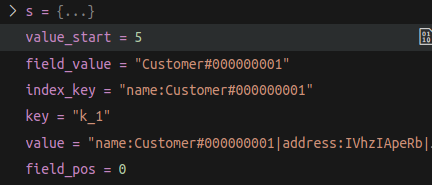|
|
1ヶ月前 | ||
|---|---|---|---|
| Report/png | 删除 | 1ヶ月前 | |
| benchmarks | 删除 | 1ヶ月前 | |
| cmake | 删除 | 1ヶ月前 | |
| db | 删除 | 1ヶ月前 | |
| doc | 删除 | 1ヶ月前 | |
| helpers/memenv | 删除 | 1ヶ月前 | |
| include/leveldb | 删除 | 1ヶ月前 | |
| issues | 删除 | 1ヶ月前 | |
| port | 删除 | 1ヶ月前 | |
| table | 删除 | 1ヶ月前 | |
| test | 删除 | 1ヶ月前 | |
| third_party | 删除 | 1ヶ月前 | |
| util | 删除 | 1ヶ月前 | |
| .clang-format | 1ヶ月前 | ||
| .gitignore | 1ヶ月前 | ||
| .gitmodules | 1ヶ月前 | ||
| AUTHORS | 1ヶ月前 | ||
| CMakeLists.txt | 1ヶ月前 | ||
| CONTRIBUTING.md | 1ヶ月前 | ||
| LICENSE | 1ヶ月前 | ||
| NEWS | 1ヶ月前 | ||
| README.md | 1ヶ月前 | ||
| TODO | 1ヶ月前 | ||
README.md
实验报告:在 LevelDB 中构建二级索引的设计与实现
实验目的
在 LevelDB 的基础上设计和实现一个支持二级索引的功能,优化特定字段的查询效率。通过此功能,用户能够根据字段值高效地检索对应的数据记录,而不需要遍历整个数据库。
实现思路
1. 二级索引的概念
二级索引是一种额外的数据结构,用于加速某些特定字段的查询。在 LevelDB 中,键值对的存储是以 key:value 的形式。通过创建二级索引,我们将目标字段的值与原始 key 建立映射关系,存储在独立的索引数据库中,从而支持基于字段值的快速查询。
例如,原始数据如下:
k_1 : name:Customer#000000001|address:IVhzIApeRb|phone:25-989-741-2988
k_2 : name:Customer#000000002|address:XSTf4,NCwDVaW|phone:23-768-687-3665
k_3 : name:Customer#000000001|address:MG9kdTD2WBHm|phone:11-719-748-3364
为字段 name 创建索引后,索引数据库中的条目如下:
name:Customer#000000001-k_1 : k_1
name:Customer#000000001-k_3 : k_3
name:Customer#000000002-k_2 : k_2
2. 设计目标
- 创建索引:扫描数据库中的所有记录,基于指定字段提取值,并将字段值和原始
key编码后写入二级索引数据库indexDb_。 - 查询索引:在二级索引数据库中快速定位字段值对应的原始
key。 - 删除索引:移除二级索引数据库中所有与目标字段相关的条目。
具体实现
1. DBImpl 类的设计
在 LevelDB 的核心类 DBImpl 中,增加了对二级索引的支持,包括:
- 索引字段管理:使用成员变量
fieldWithIndex_保存所有已经创建索引的字段名。 - 索引数据库:使用成员变量
indexDb_管理二级索引数据库。
class DBImpl : public DB {
private:
std::vector<std::string> fieldWithIndex_; // 已创建索引的字段列表
leveldb::DB* indexDb_; // 存储二级索引的数据库
};
2. 二级索引的创建
在 DBImpl 中实现 CreateIndexOnField 方法,用于对指定字段创建二级索引:
- 遍历主数据库中的所有数据记录。
- 解析目标字段的值。
- 在索引数据库中写入二级索引条目,键为
"fieldName:field_value-key",值为原始数据的键。
核心代码:
Status DBImpl::CreateIndexOnField(const std::string& fieldName) {
// 检查字段是否已创建索引
for (const auto& field : fieldWithIndex_) {
if (field == fieldName) {
return Status::InvalidArgument("Index already exists for this field");
}
}
// 添加到已创建索引的字段列表
fieldWithIndex_.push_back(fieldName);
// 遍历主数据库,解析字段值并写入索引数据库
leveldb::ReadOptions read_options;
leveldb::Iterator* it = this->NewIterator(read_options);
for (it->SeekToFirst(); it->Valid(); it->Next()) {
std::string key = it->key().ToString();
std::string value = it->value().ToString();
// 提取字段值
size_t field_pos = value.find(fieldName + ":");
if (field_pos != std::string::npos) {
size_t value_start = field_pos + fieldName.size() + 1;
size_t value_end = value.find("|", value_start);
if (value_end == std::string::npos) value_end = value.size();
std::string field_value = value.substr(value_start, value_end - value_start);
std::string index_key = fieldName + ":" + field_value;
// 在索引数据库中创建条目
leveldb::Status s = indexDb_->Put(WriteOptions(), Slice(index_key), Slice(key));
if (!s.ok()) {
delete it;
return s;
}
}
}
delete it;
return Status::OK();
}
3. 二级索引的查询
在 DBImpl 中实现 QueryByIndex 方法,通过目标字段值查找对应的原始键:
- 在索引数据库中遍历
fieldName:field_value开头的条目。 - 收集结果并返回。
核心代码:
std::vector<std::string> DBImpl::QueryByIndex(const std::string& fieldName) {
std::vector<std::string> results;
leveldb::ReadOptions read_options;
leveldb::Iterator* it = indexDb_->NewIterator(read_options);
for (it->Seek(fieldName); it->Valid(); it->Next()) {
std::string value = it->value().ToString();
if (!value.empty()) {
results.push_back(value);
}
}
delete it;
return results;
}
4. 二级索引的删除
在 DBImpl 中实现 DeleteIndex 方法,通过目标字段名移除对应的所有索引条目:
- 在
fieldWithIndex_中移除字段。 - 遍历索引数据库,删除所有以
fieldName:开头的条目。
核心代码:
Status DBImpl::DeleteIndex(const std::string& fieldName) {
auto it = std::find(fieldWithIndex_.begin(), fieldWithIndex_.end(), fieldName);
if (it == fieldWithIndex_.end()) {
return Status::NotFound("Index not found for this field");
}
// 从已创建索引列表中移除字段
fieldWithIndex_.erase(it);
// 遍历索引数据库,删除相关条目
leveldb::ReadOptions read_options;
leveldb::Iterator* it_index = indexDb_->NewIterator(read_options);
for (it_index->SeekToFirst(); it_index->Valid(); it_index->Next()) {
std::string index_key = it_index->key().ToString();
if (index_key.find(fieldName + ":") == 0) {
Status s = indexDb_->Delete(WriteOptions(), Slice(index_key));
if (!s.ok()) {
delete it_index;
return s;
}
}
}
delete it_index;
return Status::OK();
}
示例流程
- 插入原始数据:
k_1 : name:Customer#000000001|address:IVhzIApeRb|phone:25-989-741-2988 k_2 : name:Customer#000000002|address:XSTf4,NCwDVaW|phone:23-768-687-3665 - 创建索引:
- 调用
CreateIndexOnField("name"),索引数据库生成条目:name:Customer#000000001-k_1 : k_1 name:Customer#000000002-k_2 : k_2
- 调用
- 查询索引:
- 调用
QueryByIndex("name:Customer#000000001"),返回["k_1"]。
- 调用
- 删除索引:
- 调用
DeleteIndex("name"),移除所有name:开头的索引条目。
- 调用
测试结果:
- 插入时间 (Insertion time for 100001 entries: 516356 microseconds)
这个时间(516356 微秒,约 516 毫秒)看起来是合理的,特别是对于 100001 条记录的插入操作。如果你的数据插入过程没有特别复杂的计算或操作,这个时间应该是正常的,除非硬件性能或其他因素导致延迟。
- 没有索引的查询时间 (Time without index: 106719 microseconds)
这个时间是查询在没有索引的情况下执行的时间。106719 微秒(大约 107 毫秒)对于没有索引的查询来说是可以接受的,尤其是在数据量较大时。如果数据库没有索引,查找所有相关条目会比较耗时。
- 创建索引的时间 (Time to create index: 596677 microseconds)
这个时间(596677 微秒,约 597 毫秒)对于创建索引来说是正常的,尤其是在插入了大量数据后。如果数据量非常大,索引创建时间可能会显得稍长。通常情况下,创建索引的时间会随着数据量的增加而增大。
- 有索引的查询时间 (Time with index: 68 microseconds)
这个时间(68 微秒)非常短,几乎可以认为是一个非常好的优化结果。通常,索引查询比没有索引时要快得多,因为它避免了全表扫描。因此,这个时间是非常正常且预期的,说明索引大大加速了查询。
- 查询结果 (Found 1 keys with index)
这里显示索引查询找到了 1 个键。是正常的, name=Customer#10000 应该返回 1 条记录。
- 数据库统计信息 (Database stats)
Compactions
Level Files Size(MB) Time(sec) Read(MB) Write(MB)
--------------------------------------------------
0 2 6 0 0 7
1 5 8 0 16 7
这些信息表明数据库的压缩(Compaction)过程。Level 0 和 Level 1 显示了数据库的文件数和大小。此部分数据正常,意味着数据库在处理数据时有一些 I/O 操作和文件整理。
- 删除索引的时间 (Time to delete index on field 'name': 605850 microseconds)
删除索引的时间(605850 微秒,约 606 毫秒)比创建索引的时间稍长。这个时间是合理的,删除索引通常会涉及到重新整理数据结构和清理索引文件,因此可能比创建索引稍慢。
benchmark运行结果总结:
整体来看,输出结果是正常的:
- 插入和索引创建时间:插入数据和创建索引所需的时间相对较长,但考虑到数据量和索引的生成,时间是合理的。
- 有索引的查询时间:索引加速了查询,这部分的时间(68 微秒)非常短,表现出色。
- 删除索引的时间:删除索引需要稍长时间,这也是常见的现象。
总结
本实验通过在 DBImpl 中集成索引管理功能,实现了对二级索引的创建、查询和删除。二级索引数据存储在独立的 indexDb_ 中,通过高效的键值映射提升了字段值查询的效率。



